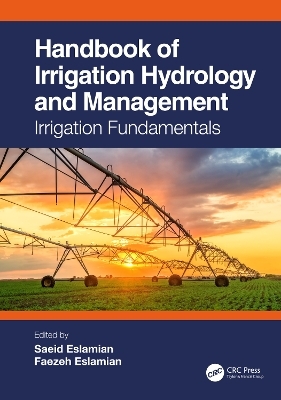
Handbook of Irrigation Hydrology and Management
CRC Press (Verlag)
978-1-032-45745-1 (ISBN)
- Lieferbar (Termin unbekannt)
- Versandkostenfrei innerhalb Deutschlands
- Auch auf Rechnung
- Verfügbarkeit in der Filiale vor Ort prüfen
- Artikel merken
Ever-increasing population growth has caused a proportional increased demand for water, and existing water sources are depleting day by day. Moreover, with the impact of climate change, the rates of rainfall in many regions have experienced a higher degree of variability. In many cities, government utilities have been struggling to maintain sufficient water for the residents and other users. The Handbook of Irrigation Hydrology and Management examines and analyzes irrigated ecosystems in which water storage, applications, or drainage volumes are artificially controlled in the landscape and the spatial domain of processes varies from micrometers to tens of kilometers, while the temporal domain spans from seconds to centuries. The continuum science of irrigation hydrology includes the surface, subsurface (unsaturated and groundwater systems), atmospheric, and plant subsystems. Further, the book includes coverage of environmental and economic impacts, water quality issues, water harvesting, satellite measurements for irrigation, and more.
Features:
Offers water-saving strategies to increase the judicious use of scarce water resources
Presents strategies to maximize agricultural yield per unit of water used for different regions
Compares irrigation methods to offset changing weather patterns and impacts of climate change
Dr. Saeid Eslamian is professor of Hydrology at Isfahan University of Technology, where he heads the Hydrology Research Group in the Department of Water Engineering. His research focuses mainly on statistical and environmental hydrology and climate change. In particular, he is working on modeling and prediction of natural hazards including flood, drought, storms, wind, groundwater drawdown, and pollution for arid and semi-arid zones, particularly in urban areas. He is also a Visiting Professor at Princeton University, and University of ETH Zurich, Switzerland. He has contributed to more than 300 publications in books, research journals, and technical reports or papers in conferences. He is the Founder and Editor-in-Chief of both the International Journal of Hydrology Science and Technology and the Journal of Flood Engineering. He received ASCE and EWRI awards in 2009 and 2010 for his research. Dr. Faezeh Eslamian current research focuses on the fate and transport of phosphorus through subsurface drained farmlands. Dr. Eslamian completed her PhD at McGill University, and her bachelor’s and master’s degrees in civil and environmental engineering from Isfahan University of Technology, Iran, where she evaluated natural and low-cost absorbents for the removal of pollutants such as textile dyes and heavy metals. Furthermore, she has conducted research on the worldwide water quality standards, wastewater reuse, and drought guidelines.
Part I: Irrigation Hydrology. 1. Irrigation Hydrology: Landscape, Scales and Social Context. 2. Infiltration and Irrigation Management. 3. Movement of Water in Soil. Part II: Evapotranspiration and Water Requirements. 4. An Introduction to Soil-Water-Plant Relationship. 5. Plant Evapotranspiration-Concepts and Problems. 6. Plant Water Requirements and Evapotranspiration. Part III: Environmental and Economical Impacts. 7. Environmental Impacts of Irrigation. 8. Environmental Impact Assessment of Irrigation. 9. Economic Viability of Irrigation Techniques. Part IV: Earth and Satellite Measurements for Irrigation. 10. Irrigation Water Measurement. 11. Irrigation and Agrometeorology: Innovative Remote Sensing Applications in Crop Monitoring. Part V: Irrigation Water Quality Issues. 12. Irrigation with Reclaimed Municipal Wastewater: Opportunity or Risks. 13. Microbiology of Irrigation Water. 14. Phosphate and Nitrate Management in Irrigation Water. 15. Use of Typha Latifolia as a Tool for Biomonitoring of Domestic Effluents: Biochemical and Biomarkers Study. Part VI: Water Harvesting for Irrigation. 16. Surface Runoff Water Harvesting for Irrigation. 17. Water Harvesting for Rainfed Farming. 18. Optimization of Reservoir Operation for Irrigation. 19. Reducing Nitrate Leaching and Increasing Nitrogen Use Efficiency by Applying Nano-Fertilizers.
| Erscheinungsdatum | 16.03.2023 |
|---|---|
| Zusatzinfo | 43 Tables, black and white; 68 Line drawings, black and white; 51 Halftones, black and white; 119 Illustrations, black and white |
| Verlagsort | London |
| Sprache | englisch |
| Maße | 178 x 254 mm |
| Gewicht | 750 g |
| Themenwelt | Technik ► Maschinenbau |
| Technik ► Umwelttechnik / Biotechnologie | |
| ISBN-10 | 1-032-45745-7 / 1032457457 |
| ISBN-13 | 978-1-032-45745-1 / 9781032457451 |
| Zustand | Neuware |
| Informationen gemäß Produktsicherheitsverordnung (GPSR) | |
| Haben Sie eine Frage zum Produkt? |
aus dem Bereich


